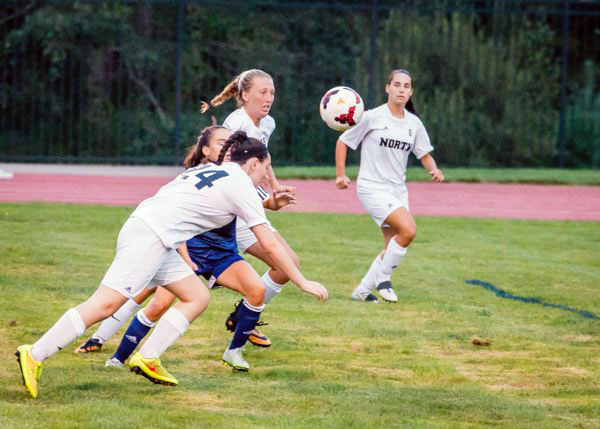Head Games: NK students deal with the concussion trend

Senior Shannon Coleman and junior Brooke Osmanski compete for a head ball against a defender. Both players suffered concussions in this soccer season.
This year, between 1.6 million to 3.8 million concussions will occur, and 5-10% of all athletes will experience a concussion in any given sport season. Concussions have been popular in sports, and new technology and rules are being developed to help prevent them.
The center for Disease Control and Prevention defines a concussion as “a type of traumatic brain injury—or TBI—caused by a bump, blow, or jolt to the head or by a hit to the body that causes the head and brain to move rapidly back and forth. This sudden movement can cause the brain to bounce around or twist in the skull, stretching and damaging the brain cells and creating chemical changes in the brain.” They can be caused from different things, but most commonly sports.
“A concussion can impact a student greatly,” said NK’s Athletic Trainer Emma Ofner. “Depending on the severity of the concussion, an athlete can suffer from short term memory loss, loss of motor and sensor skills, and in very serious cases, blood clots in the brain itself causing hematomas in various parts of the brain.”
8A concussion does not always mean loss of consciousness, as there are many different symptoms. Other symptoms include confusion, headaches, dizziness, and nausea. They can come in different levels, from minor to major concussions. The effects of a concussion can last a lifetime, especially if more than one occurs.
According to the Concussion Treatment Center, football is the most common sport for concussions among males, with a 75% chance for concussion. Soccer is the most common sport for concussions with females, with a 50% of getting one.
Junior Brooke Osmanski has been diagnosed with two concussions, and has had two possible concussions. The first she received as a freshmen, when she hit her head on a high volt pole during track. “My concussion felt like I was nauseous, dizzy, I was sensitive light, and it hurt to think and concentrate,” said Osmanski. The second was this year during a soccer playoff game, when she collided with another player and hit her head on the ground.
For her recovery, Osmanski was not allowed to take tests, quizzes, do homework, or any physical activity for a week. She was also not allowed to watch television or go on her phone and spent a lot of her time in a dark room. “I think that concussions are a part of the game and if you are playing that game then it is what happens,” said Osmanski. “I do not think games should be changed to prevent concussions, but instead [equipment should be changed] for concussion prevention.”
This year, U.S Soccer Organization has released a new rule in efforts to reduce the numbers of youth concussions. They have banned heading the ball for players under ten and have ordered coaches to limit heading only in games for kids 10 to 13 years old. This caused many controversy; people questioned if the new ban on heading was taking things to far or if more should be done to prevent injuries.
“I think if you learn to head the ball properly there is no worry about receiving a concussion from poor technique,” said Assistant Boys Soccer Varsity and J.V. head coach Paul Fanning. “I think it is an overreaction, but they [U.S Soccer] can’t guarantee that kids will learn to head properly so they have to create a way to protect the kids.”
Many concussions,2 especially those in sports, can happen due to a buildup of getting hit in the head. In September, Senior and Captain of the Football team, Shawn Gibbs, received multiple blows to the head. After feeling dizzy, severe nausea, and having trouble with vision and speech, Gibbs was diagnosed with a moderate concussion. To recover, Gibbs had to stay at home with the lights out and rest. His overall recovery took a few weeks.
This Christmas, a new movie directed by Peter Landesman will be premiering in theaters across the nation. The controversial movie, “Concussion” is about forensic pathologist Dr. Bennet Omalu (Will Smith) discovering the traumatic effects of these head injuries on NFL football players. This movie helped sparked the conversation of whether or not rules should be made in football to stop the number of head related injuries players receive. “I think with football, people will always get hit in the head,” said Gibbs. “But I also think that it is important that players learn how to hit without injuring their head. In practice, we go over different drills where we learn how to hit properly without using our head.
Students with any questions can visit trainer Ofner after school in the trainers room or can call the national concussion hotline.“If an athlete is noticing any symptoms they should report them right away to their parents, coaches, and athletic trainer (me),” said Ofner. “If the symptoms are severe than a doctor visit is needed. If a student cannot wait for an appointment because of the severity of the symptoms, then visiting the ER is strongly recommended.”
Your donation will support the student journalists of North Kingstown High School. Your contribution will allow us to distribute a print edition of the Current Wave to all students, as well as enter journalism competitions.










